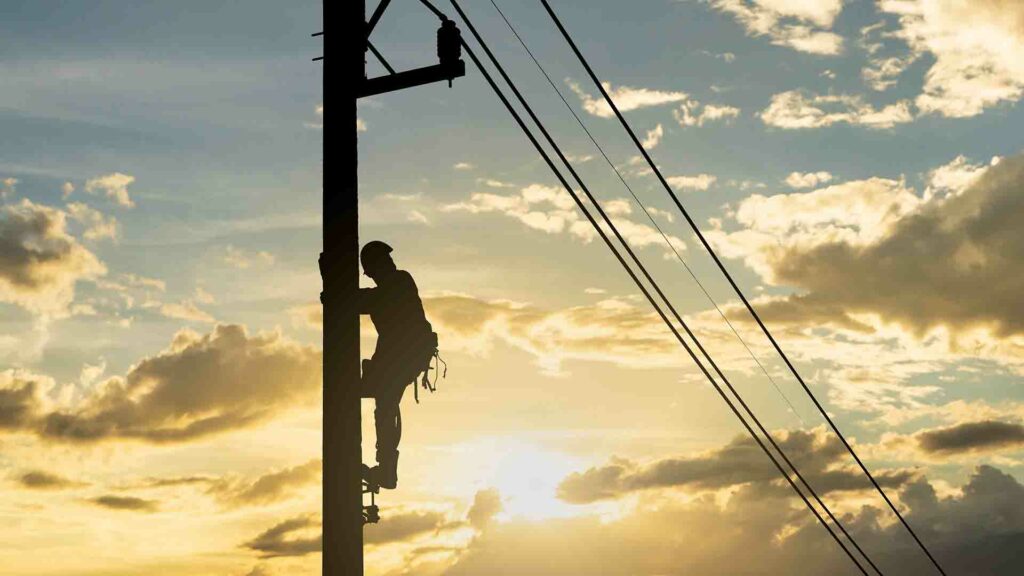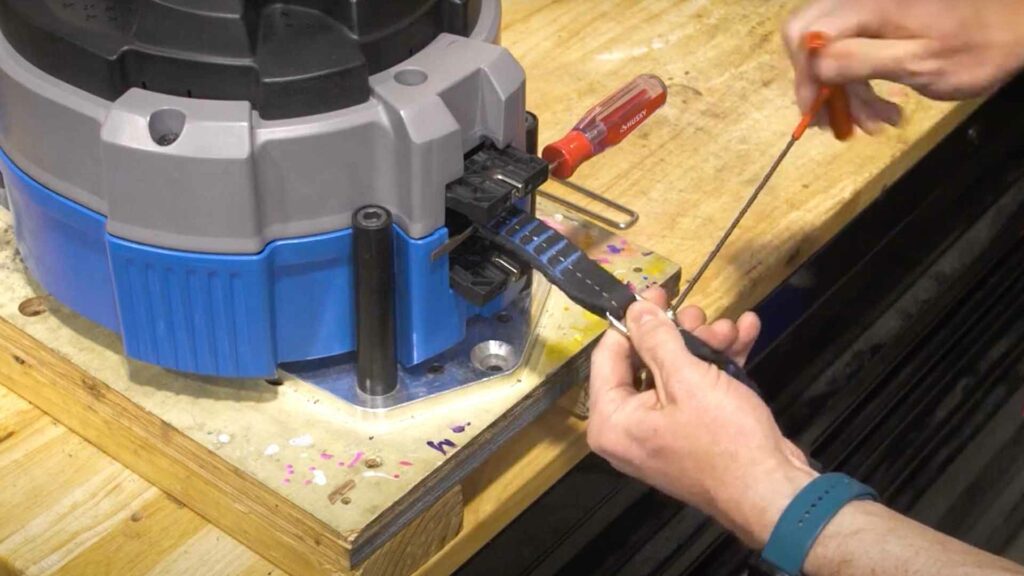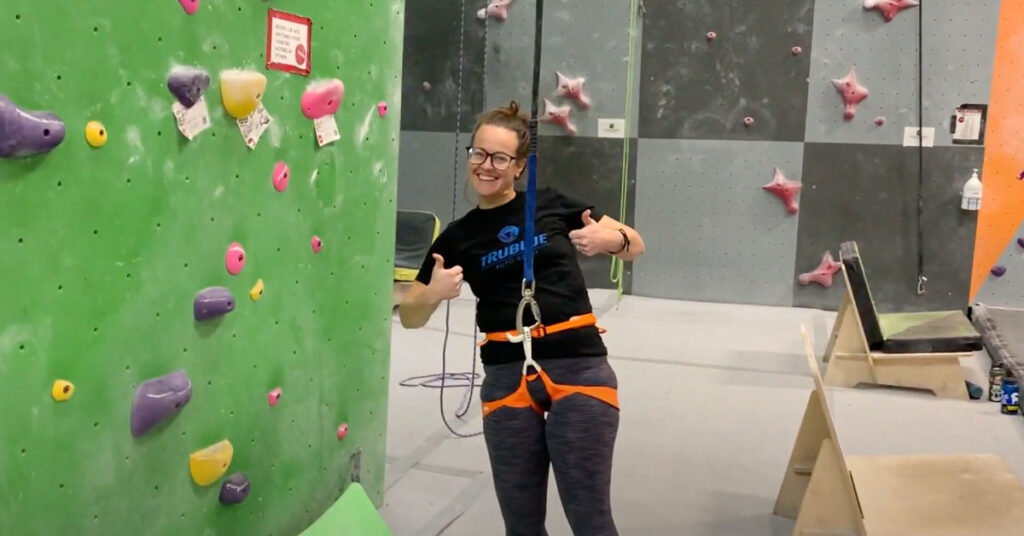A quick Google search is all it takes to see that there are hundreds of great climbing games to choose from. Unfortunately, once you start to go through those lists, you’ll quickly discover that most climbing games aren’t suitable for a Fun Climb or FEC environment.
There are several factors that can make a climbing game a good idea in a climbing gym, but not in a Fun Climb. Some climbing games are too difficult for younger or beginner climbers, some games are too reliant on climbing gym elements such as specific holds or overlapping routes, some games require a bouldering wall or a belay partner, and many climbing games prioritize the fitness side of climbing over simply having fun.
Rather than sorting through the lists of climbing games for yourself and trying to find the diamonds in the rough, in this article we’ve narrowed them down to the top five climbing games that you can play at your Fun Climb or Family Entertainment Center.
The games were chosen based on the following criteria:
- Appropriate for young and beginner climbers
- Emphasis on fun
- Climbing walls do not require multiple routes or holds with specific colors
- Games can be played while attached to an auto belay
One last note: when deciding on rankings, priority was given to climbing games that are engaging for parents and other spectators, as well as games that would be especially fun at birthday parties, private parties, and special events.
Without further ado, let’s countdown the top 5 climbing games to play at your Fun Climb or FEC.
5. Simon Says
This classic kids’ game makes a great addition to any birthday party or group event. Of course, playing Simon Says on a climbing wall gives the game an extra twist, along with a higher challenge factor.
For the best results, you’ll want multiple kids from the same group starting up the climbing wall at the same time. Choose a Simon from amongst the parents or, if they are up for it, the auto belay operator. From the base of the wall, Simon will call up commands for the climbers to follow:
“Simon says, grab the nearest hold to the right!”
“Simon says, raise your right foot!”
“Simon says, scratch your nose!”
The more creative you get with your instructions, the more fun the game will be for all of the players involved (and the spectators, too!). Rather than trying to make it to the top, the object of this version of Simon Says is to be the last climber remaining on the wall.
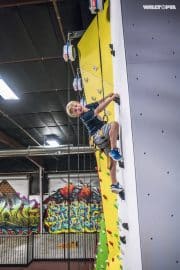
Trying to pick out that next move at Adventure HQ
4. Laser Pointer
Outside of playing games, laser pointers can be helpful for beginner climbers who have a hard time deciding what their next move should be. However, once the climber has built up a little bit of confidence, that helpful laser-guided instruction can quickly turn into a surprisingly fun (and funny) game for both the climber and the person with the laser pointer.
The game works like this: instead of taking someone up the easiest or most obvious way, by using the laser pointer, you can throw in a few curveballs. Instead of going straight up the wall, maybe you want to lead your climber up a weird and wandering path. Maybe you want them to jump for a hold! It’s entirely up to you.
Why is this game great for FECs?
Especially at a Family Entertainment Center, where climbing holds are not changed very often (if ever) and climbing memberships mean that some kids have already climbed the existing walls multiple times, using a laser pointer can keep things fresh and fun, without requiring operators to make any physical changes to the climbing walls.
3. Dress Up
This game is a fan favorite at private events--though it does require a small amount of setup.
Before you start to play, have a more experienced climber hang a series of clothing items from the climbing holds. These items can range from the ordinary (hats, ponchos, and oversized t-shirts) to the more exotic (oven mitts, tiaras, feathered boas, or whatever else you can dream up, just so long as the clothing won’t interfere with the harness or webbing line).
Each time a climber reaches a new item, it’s their job to figure out how to put on the new piece of clothing without letting go of the wall. This usually involves a great deal of wobbling, swaying, and teetering, which may or may not end in disaster.
As the climber gets higher, try increasing the difficulty of the clothing items. For example, start off with something easy like a hat towards the bottom of the wall, while saving challenging items like t-shirts for closer to the top.
Since this game involves a large amount of fiddling, we do recommend using an anti-release connector, such as a Self Belay, when/if you decide to allow private groups to play. Self Belays require a key to unlock and are specifically designed to prevent users from accidentally unclipping themselves from the auto belay while the device is in use.
2. Take Flight
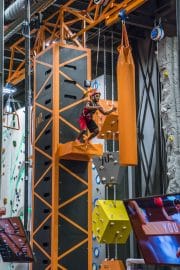
Taking to the sky at Sky Zone Trampoline Park in Chicago
One of the unsung features of the TRUBLUE Auto Belay is its ability to protect against shock loading. What does this mean in terms of playing games? To put it simply: you can jump!
In practice, we’ve seen this feature utilized in a variety of ways by a variety of Family Entertainment Centers. One of the most exciting uses is the leap of faith (pictured). All you need for this game is an elevated platform, a hanging inflatable, and a TRUBLUE. The goal is to leap from the platform and then hang on for as long as possible.
Another way to gamify this feature is to set up a dyno on your climbing wall. Dynos are among the most exciting moves in climbing. In climbing terms, a dyno (or dynamic movement) is used when a hold is too far away to reach while standing still. Instead, the climber is forced to let go of the wall and launch themself towards the hold.
A dyno adds a thrilling top out to any climbing route. But keep in mind: if you’re going to set one up, be sure to use large, easy-to-grab handholds and more than the usual number of footholds to accommodate climbers of all different heights.
1. Go for the Gold
One of the biggest current trends in the sport of climbing today is Speed Climbing. In fact, Speed Climbing has become so popular that, for the first time ever, it will be a standalone competition at the 2024 Olympics Games in Paris.
For Fun Climbs or FECs that have the capability to changeout holds, one option for joining in on the Speed Climbing mania is to build your very own miniature speed wall. In practice, this doesn’t have to be as complicated as it sounds. All Speed Climbing walls share one thing in common: a very specific type of climbing hold. Unfortunately, the official holds used for Speed Climbing can often be too difficult for beginning climbers. So, if you want to design your own miniature speed wall, adding similarly colored holds will make it instantly recognizable; however, you might consider using shapes that are a little more beginner friendly.
For FECs that are unable to change their climbing holds, the solution could be as simple as a good old-fashioned stopwatch. By having two routes next to each other, kids can either race their friends to the top or race against the clock to try to beat their personal records.
Racing might be the oldest, most straight-forward game in the world, but it’s also a timeless classic that kids will play time and time again.

